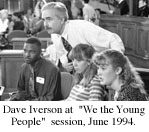Spring 1995
Still Learning After All These Years
It was D-Day (D as in debate) minus two, and Bill Clinton’s campaign team had come down with a case of techno-jitters over our multi-state “We the People” forum.
Then again, so had we.
If ever there was a high-tech house of cards waiting to tumble, this was it. In late 1991, a Minnesota media coalition asked Wisconsin Public Television and the Wisconsin State Journal to organize town hall meetings in advance of the April 7, 1992 presidential primary in both states.
Three sites (Beliot and Wausau, Wis., and St. Paul, Minn.) would be linked via satellite, and selected citizens from each of the 100-person meetings would question Democratic presidential candidates Clinton and Jerry Brown. Brown would take part from the studios of KCTA in St. Paul, while Clinton would be beamed in from Indianapolis, Ind. The result would be a 90-minute forum broadcast live in Wisconsin and Minnesota and rebroadcast on C-SPAN.
“Could you run that past us again?” asked Clinton’s top advisers, who had yet to encounter anything quite so elaborate on the campaign trail. A town hall meeting with a roof big enough to cover three states — Wisconsin, Minnesota and Indiana? Organized, not by a major network, but by local television stations, daily newspapers and a half-dozen corporate, foundation and academic sponsors? The Clinton team was close to backing out.
“Trust us” was our collective reply. They did — and it worked. Members of our new partnership pitched in to make sure key issues were covered in the newspapers, that citizens discussed those issues and framed questions in the town hall meetings, and that the broadcast itself clicked like a light switch.
When it was over, we were struck by what had taken place. Two mediums — television and newspapers — that had all but taken people out of the political process by contributing to their sense of civic impotence had collaborated to draw them back. For us, it was an intoxicating change in the way we had come to think of our trade. After years of worrying about how to keep a proper distance from the people and communities we covered, we had helped to reconnect people, not only with their political candidates but with themselves.
Three years later, the “We the People/ Wisconsin” project is alive because we continue to hold to the ideal of citizen re-engagement that guided our first foray into what we later learned was “civic journalism.” But it’s alive and well because we have learned from our mistakes as well as our successes. For those who plan to head down this rewarding but challenging trail, here are some markers that may help you find your way.
1. Nourish your partnership. It’s the only one you’ve got.
As we enter our fourth season, “We the People/Wisconsin” has grown from its three original partners (the State Journal, public television and the Wood Communications Group) to include WISC-TV, the CBS affiliate in Madison, and Wisconsin Public Radio. Meetings that used to take place over beers and burgers at a local tavern now require more planning on the front end and more follow-up on the back side.
Most of all, our larger partnership has taught us to include everyone in the decision-making process from the start, and to pay attention to their needs throughout. It’s no small trick to keep inherently competitive interests — public versus commercial TV, radio versus other broadcasters, newspapers versus everyone — at the same table. But it begins with checking your stereotypes at the door and coming to respect what talents your partners bring to the party.
We’ve learned that the whole is greater than the sum of our individual parts. In the weeks leading up to one of our live specials, all three media report on the selected topic. We conduct preliminary town hall meetings around the state to begin a statewide conversation on the issue at hand. Reports appear on the front page as well as the editorial page, on the six o’ clock news, on magazine shows and on call-in radio. Finally, the live special is simulcast on the state public television and radio network as well as WISC-TV. On the day of the event, newspapers stories help promote the program; the next day there is a full report on what happened. Because our political debates have often been turning-point events during an election year, the programs receive front-page attention in other newspapers around the state.

